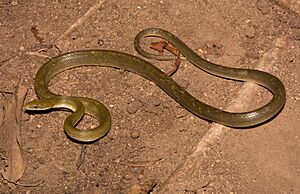Green rat snake facts for kids
Quick facts for kids Green rat snake |
|
|---|---|
 |
|
| Northern green ratsnake (Senticolis triaspis intermedia) from Sonora, México | |
| Conservation status | |
| Scientific classification | |
| Genus: |
Senticolis
|
| Species: |
triaspis
|
| Subspecies | |
|
Three, see text. |
|
| Synonyms | |
Senticolis is a genus of nonvenomous snake in the family Colubridae. The genus Senticolis is monotypic, containing the sole species Senticolis triaspis, also known as the green rat snake. The species is endemic to Central America, Mexico, southern Arizona, and southern New Mexico.
Description
Senticolis triaspis may grow to a total length (including tail) of 160 cm (63 in). Dorsally, it is green or olive green, and ventrally it is light yellow. The head is elongated, the body is slender, and the smooth dorsal scales are arranged in 31–39 rows.
Habitat
Senticolis triaspis usually inhabits evergreen forests and grassland.
Geographic range
Senticolis triaspis is well distributed in the Baboquivari, Pajarito, Atascosa, Santa Rita, Empire, Patagonia, Chiricahua, Swisshelm, Pedregosa, and Peloncillo mountains of southeastern Arizona.
Diet
Senticolis triaspis consumes small animals such as lizards, birds, and bats, killing them by deadly constriction.
Behavior
Senticolis triaspis is primarily diurnal.
Reproduction
An adult female of S. triaspis is able to lay up to nine eggs in a clutch.
Subspecies
Three subspecies are recognized as being valid, including the nominotypical subspecies.
- Senticolis triaspis intermedia (Boettger, 1883) – Arizona, New Mexico, northern Mexico
- Senticolis triaspis mutabilis (Cope, 1885) – Central America
- Senticolis triaspis triaspis (Cope, 1866) – southern Mexico
Nota bene: A trinomial authority in parentheses indicates that the subspecies was originally described in a genus other than Senticolis.


